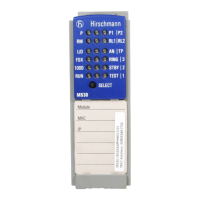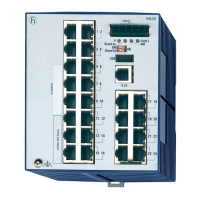Time
62
4.2
SNTP configuration
RM Web L3P
Release
4.1
03/08
In "VLAN ID" you specify the VLAN to which the device may periodically
send SNTP packages.
In "Anycast send interval" you specify the interval at which the device
sends SNTP packets (valid entries: 1 second to 3600 seconds, on deliv-
ery: 120 seconds).
With "Disable Server at local time source" the device disables the SNTP
server function if the status of the time source is "local" (see Time dialog).
X Configuration SNTP Client
In "External server address" you enter the IP address of the SNTP
server from which the device periodically requests the system time.
In "Redundant server address" you enter the IP address of the SNTP
server from which the device periodically requests the system time, if
it does not receive a response to a request from the "External server
address" within 0.5 seconds.
Note: If you are receiving the system time from an external/redundant
server address, you do not accept any SNTP broadcasts (see below).
Otherwise you can never distinguish whether the device is displaying
the time from the server entered, or that of an SNTP broadcast packet.
In "Server request interval" you specify the interval at which the device
requests SNTP packets (valid entries: 1 second to 3600 seconds, on
delivery: 30 seconds).
With "Accept SNTP Broadcasts" the device takes the system time
from SNTP broadcast/Multicast packets that it receives.
With "Threshold for obtaining the UTC" you can reduce the frequency
of time alterations. Enter the threshold in milliseconds. The device
changes the time as soon as the deviation from the server time is
above this threshold.
IP destination
address
Send SNTP packets
periodically to
0.0.0.0 Nobody
Unicast Unicast
224.0.1.1 Multicast
255.255.255.255 Broadcast
Table 6: Periodic sending of SNTP packets

